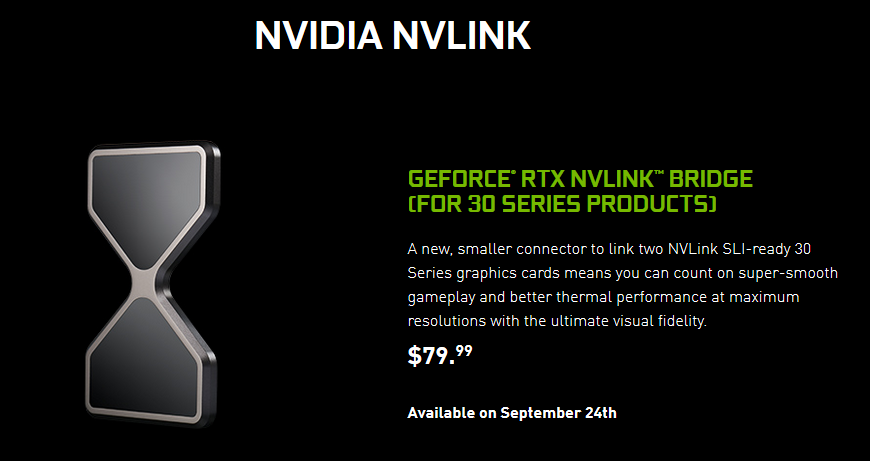Nvidia To Support NVLink Only for RTX 3090
$3,100 for SLI that games don't even support
It's no secret that Nvidia SLI is basically dead for games and graphics cards. While Nvidia supported NVLink on the RTX 2070 Super, 2080 Super, and RTX 2080 Ti, it was never really worth it from a performance perspective in gaming due to underwhelming scaling. Now, with the RTX 30-series cards based on the Ampere architecture, Nvidia is dropping NVLink on all cards but the top-tier GeForce RTX 3090.
Normally, we'd be upset at a development like this, but now it doesn't really seem to matter. A few generations ago, it was still easily possible to overwhelm even the best graphics cards with the games of that time, but if Nvidia's promises are true, we shouldn't need more power than what the GeForce RTX 3070, GeForce RTX 3080, and particularly the RTX 3090 can provide by themselves.

If the RTX 3080 can power 4K gaming at high framerates and ultra settings, do you really need more GPU power? With the RTX 3080 packing 8704 CUDA cores, and the RTX 3090 a staggering 10,496, probably not — especially with the developments in DLSS, Nvidia's AI-powered upscaling technology. At least not for gaming purposes.
The RTX 3070 is supposed to be faster than the RTX 2080 Ti, and the RTX 3080 is double the RTX 2080 performance. Plenty of games already run into CPU bottlenecks at 1080p, and with even faster graphics cards coming, 1440p will be in a similar state on Nvidia's top two GPUs. Doubling down on the RTX 3080 would probably only yield a 25% boost in performance, and that's still only in games that support multi-GPU.
How many demanding games of the past two years have even bothered with multi-GPU support? None of the ray tracing enabled games have done so, and even games that have SLI profiles (e.g., Star Wars: Jedi Fallen Order) had questionable results. Slightly higher average performance but with substantially worse minimum fps means lots of microstutter. It's not a great experience, and the amount of developer effort required to get it working properly is generally more than publishers are willing to invest.

Of course, if you're dead-set on an NVLink setup, it's not entirely impossible. You'll need two RTX 3090's and an NVLink bridge for $79, bringing the total price tag to an eye-watering $3077. Plus tax.
Getting more GPU power isn't just about gaming, of course. If you're running GPU compute algorithms, doing AI research, or other non-gaming work, a pair of RTX 3090 cards might be just what you need. That's why Nvidia's DGX A100 comes with eight A100 GPUs linked up via NVSwitch. It's why Intel's Xe HP and Xe HPC will be able to scale compute performance nearly perfectly by adding additional GPU tiles. The difference is that such workloads aren't normally done in real-time, requiring synchronization between display updates down to the millisecond.
Get Tom's Hardware's best news and in-depth reviews, straight to your inbox.
We've generally stopped bothering with multi-GPU benchmarks in games, simply because it's a rarity for it to work without headaches and fiddling. Having two GPUs in your gaming rig will even reduce performance in many games. If you're hoping to break benchmark records in 3DMark, yes, multi-GPU will help. But for regular games? It's just not worth the hassle.
Niels Broekhuijsen is a Contributing Writer for Tom's Hardware US. He reviews cases, water cooling and pc builds.
-
GenericUser ReplyScrewySqrl said:IMHO this is proof that SLI is basically dead
There's plenty of people that will insist it's not dead, but the trend I've seen myself over the years while running an SLI setup up until very early this year, is that support for it has been rapidly diminishing over time. More and more games for me have either needed an inordinate amount of time to get the configuration right to actually make use of the second GPU, a bunch of tweaks to prevent graphic artifacts, work but scale abysmally, or just straight up will not run with a second GPU.
I'm guessing that the lack of support pushes people away from using it, causing developers to want to put less effort in supporting a setup that a minority of gamers will use anyway, which leads to even fewer people wanting to run multi-GPU, and thus the vicious cycle continues. The fact that single GPU setups can hold their own pretty well these days also sinks it deeper into obsolescence in my mind.
It's only an anecdotal experience, but it's more than enough for me to know which direction I'm going for future upgrades. -
cirdecus I'm going to play devils advocate here. There are plenty of games of the current generation that support SLI and have huge improvements, including Shadow of the Tomb Raider (which most struggled to run on max settings at 4k with a 2080Ti getting a solid 60fps. I'm a little shocked the author didn't even acknowledge the new flight simulator 2020 which can't even be played at max settings without 2080Ti's in SLI. Back in the day, it was true that you could easily overwhelm a single card, but that's because developers pushed the envelope. Without SLI, developers will be skittish to do anything outside of what a solid single card can handle. Besides, what if we have people who really do want to game at 8k in a few years with max settings enabled?Reply
NVLINK shouldn't be dead IMO. I see ray tracing as something that could easily advance in games to overwhelm these cards and lets not forget trying to play VR titles in this way.
I have a 2080Ti NVLINK setup and it saved my having to tune down settings in a number of games. Try maxing out red dead redemption 2 on a 4k machine with your 2080TI. You can't. It's not even playable without SLI.
Yes it's nuts for most people buying 2 cards and no I don't think NVLINK has a place in mainstream, but it also serves the purpose of inspiring developers to go over the top and I think we should all be trying to push the envelope here.
If you're worried about the current state of VR or CPU bottlenecking, just imagine how Intel is going to respond in the coming months and year to AMDs Ryzen. I bet another round of next gen VR headsets are around the corner too. -
nofanneeded This article is wrong and full of nonsense , First the scaling s very good when the game supports SLI can be upto 90%Reply
... Second , no one will use SLI and game on FULL HD , SLI is for 4K experience and 8K <--- experience the Writer ignored altogether , CPU bottleneck will not happen .
Also , The Writer ignored all together Multi Screen setups !!! 4K each ! which are great for Flight simulators and racing games.
Nvidia RTX 3090 has NVlink and the RTX 3080 does not for one reason : Marketing .
For dual RTX 3080 will be at least 50% faster upto 90% faster , while the RTX 3090 is only 20% faster for more than double the price of RTX 3080 ...
Also you wont experience lower fps in some game if they dont support SLI , all what you have to do is disable SLI for such games.
The right thing to write is : If the games you play supports SLI and you want to game on 4K or 8K OR Mutlipe 4K monitors , with the same experience we have now on FHD (in the 120+fps range) , then SLI is sure for you.
And Nvidia : Plase release RTX 3080 with NVLINK ! OR reduce the price of the RTX 3090 to $1200 -
cirdecus Replynofanneeded said:This article is wrong and full of nonsense , First the scaling s very good when the game supports SLI can be upto 90%
... Second , no one will use SLI and game on FULL HD , SLI is for 4K experience and 8K <--- experience the Writer ignored altogether , CPU bottleneck will not happen .
Also , The Writer ignored all together Multi Screen setups !!! 4K each ! which are great for Flight simulators and racing games.
Nvidia RTX 3090 has NVlink and the RTX 3080 does not for one reason : Marketing .
For dual RTX 3080 will be at least 50% faster upto 90% faster , while the RTX 3090 is only 20% faster for more than double the price of RTX 3080 ...
Also you wont experience lower fps in some game if they dont support SLI , all what you have to do is disable SLI for such games.
The right thing to write is : If the games you play supports SLI and you want to game on 4K or 8K OR Mutlipe 4K monitors , with the same experience we have now on FHD (in the 120+fps range) , then SLI is sure for you.
And Nvidia : Plase release RTX 3080 with NVLINK ! OR reduce the price of the RTX 3090 to $1200
I agree 100%. Although, Nvidia can't release the 3080 with nvlink as you just said. This is the only way they got their price points correct. All of those prices from the 3070 to the 3090 are only possible without nvlink. Otherwise, the 3090 is back up to 2400 dollar territory and the 3080 is over 1000 again to keep the cannibalism low. Remember, the price is what's going to beat AMD not the top end NVLINK capability. If they swapped price for NVLINK support on the lower cards, AMD could zero in on a single card and beat it in terms of performance per dollar.
The article seamed very narrowly minded, ignoring tons of facts on the current games and success of NVLINK hitting 90% gains. They also didn't even seem to understand the business motivations of this dropping NVLINK on the lower cards. -
Zizo007 Reply
RDR2 is not fast paced, anything over 30fps is good for me. RDR2 is playable with my oced 2080 Ti I get 46-48fps maxed in the benchmark 4K but I get your point, future games will be more demanding so SLI can help. I like AMD's dual GPUs, I had an HD5970, it was a monster and the fastest at the time. It maxed Crysis over 60fps. AMD days are over though. I also agree that there shouldn't be a limit and developpers should work on dual GPUs but I guess its expensive to develop multigpus support.cirdecus said:I'm going to play devils advocate here. There are plenty of games of the current generation that support SLI and have huge improvements, including Shadow of the Tomb Raider (which most struggled to run on max settings at 4k with a 2080Ti getting a solid 60fps. I'm a little shocked the author didn't even acknowledge the new flight simulator 2020 which can't even be played at max settings without 2080Ti's in SLI. Back in the day, it was true that you could easily overwhelm a single card, but that's because developers pushed the envelope. Without SLI, developers will be skittish to do anything outside of what a solid single card can handle. Besides, what if we have people who really do want to game at 8k in a few years with max settings enabled?
NVLINK shouldn't be dead IMO. I see ray tracing as something that could easily advance in games to overwhelm these cards and lets not forget trying to play VR titles in this way.
I have a 2080Ti NVLINK setup and it saved my having to tune down settings in a number of games. Try maxing out red dead redemption 2 on a 4k machine with your 2080TI. You can't. It's not even playable without SLI.
Yes it's nuts for most people buying 2 cards and no I don't think NVLINK has a place in mainstream, but it also serves the purpose of inspiring developers to go over the top and I think we should all be trying to push the envelope here.
If you're worried about the current state of VR or CPU bottlenecking, just imagine how Intel is going to respond in the coming months and year to AMDs Ryzen. I bet another round of next gen VR headsets are around the corner too. -
Olivier_00 That's right because knowing the price, I would be interesting to check 2x 3080 with NvLink versus 3090! The reason is that you can start with 3080 and when it would be not enough you can buy a second even at a lower price at the end you will have perhaps the same performance at lower price (and only when you feel that it's necessery.)Reply
EDIT:
I would be curious to know benchmark with 2x 2080 TI NvLink vs 3080 because if you already bought a 2080 TI, and if the price drops, it worth to check -
Zizo007 Reply
"For dual RTX 3080 will be at least 50% faster upto 90% faster , while the RTX 3090 is only 20% faster for more than double the price of RTX 3080 ..."nofanneeded said:This article is wrong and full of nonsense , First the scaling s very good when the game supports SLI can be upto 90%
... Second , no one will use SLI and game on FULL HD , SLI is for 4K experience and 8K <--- experience the Writer ignored altogether , CPU bottleneck will not happen .
Also , The Writer ignored all together Multi Screen setups !!! 4K each ! which are great for Flight simulators and racing games.
Nvidia RTX 3090 has NVlink and the RTX 3080 does not for one reason : Marketing .
For dual RTX 3080 will be at least 50% faster upto 90% faster , while the RTX 3090 is only 20% faster for more than double the price of RTX 3080 ...
Also you wont experience lower fps in some game if they dont support SLI , all what you have to do is disable SLI for such games.
The right thing to write is : If the games you play supports SLI and you want to game on 4K or 8K OR Mutlipe 4K monitors , with the same experience we have now on FHD (in the 120+fps range) , then SLI is sure for you.
And Nvidia : Plase release RTX 3080 with NVLINK ! OR reduce the price of the RTX 3090 to $1200
I agree 100%, its only marketing so you pay much more for a 3090. Otherwise ppl would get 2x3080 for the price of a 3090 and have much more performance. -
Zizo007 Reply
2x3080 is significantly faster and cheaper than 1x3090. Nvidia just wants your money lolOlivier_00 said:That's right because knowing the price, I would be interesting to check 2x 3080 with NvLink versus 3090! The reason is that you can start with 3080 and when it would be not enough you can buy a second even at a lower price at the end you will have perhaps the same performance at lower price (and only when you feel that it's necessery.)
